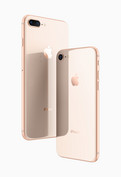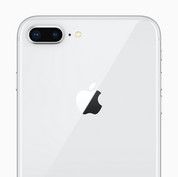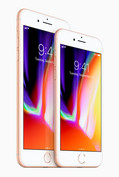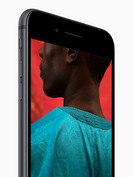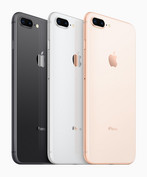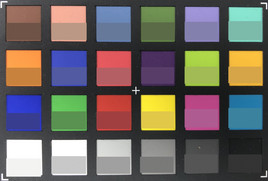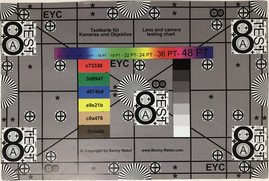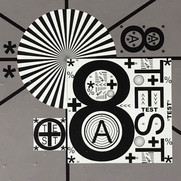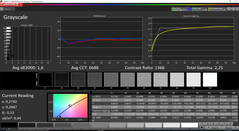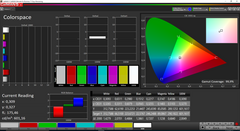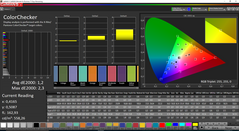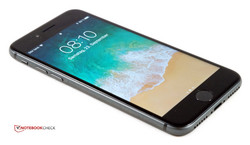Apple iPhone 8 ilk izlenimler
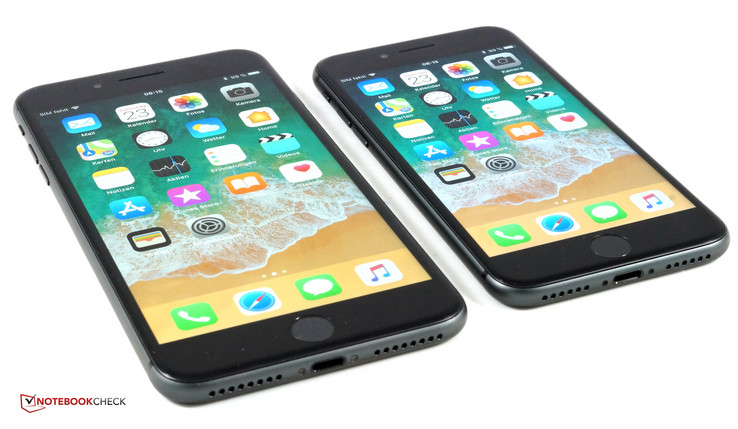
Autumn is traditionally the time for new iPhones, and Apple once again launched its latest smartphone generation this September. It was the first product announcement from Apple's own Steve Jobs Theater and it was the first time we get three new models. And that the actual high-end model, the iPhone X (don't call it "X", it's "10") will be launched a couple of weeks later was already assumed. The new iPhone 8 & iPhone 8 Plus models are available since yesterday, while the iPhone X can be preordered starting October 27th with the release on November 3rd – at least if you are amongst the first customers. Right now, it looks like Apple cannot ship sufficient amounts since we expect a huge demand.
However, this article is about the two "classic" models with the familiar home button operating concept including fingerprint scanner as well as a rather mediocre screen-to-body ratio. Apple also reduced the number of storage options, perhaps because of the iPhone X. The two 8th generation iPhones are only available in two storage sizes and three colors: 64 and 256 GB in Gold, Silver, and Space Gray. The color option Rose Gold, which was just introduced two years ago, is not available anymore. The same applies for the Jet Black option, which was exclusive to the iPhone 7 & iPhone 7 Plus. The new Gold color is at least very similar to the previous Rose Gold.
Good news – at least for people willing to pay for a flagship smartphone – is the price: The new entry-level model ships at $699 and is therefore $50 more expensive, but you also get twice the storage at 64 GB. The 256 GB iPhone 8 is, similar to the iPhone 7, still available for $849. The Plus model with the larger 5.5-inch screen adds another $100. The new iPhone X easily beats that with a starting price of $999 (64 GB).
Our test model was purchased in Apple's online store. It is the Space Gray model with 256 GB of storage.
First Impression
After three generations of minor chassis changes with a rear panel almost completely made of aluminum, Apple now returns to the material we know from the iPhone 4: Glass, both at the front and rear. This was necessary for the wireless charging (Qi standard), which is now finally supported. A quick test with a charging pod from a third-party manufacturer die not reveal any issues during charging.
All dimensions of the new iPhone generation are slightly bigger than before, but this does not affect the design or the tactile feeling. The same applies for the additional weight of 10 or 14 grams, respectively) for the iPhone 8 and iPhone 8 Plus. Thanks to the glass rear panel, the iPhone 8 feels even slightly more sophisticated compared to its aluminum predecessor. The stability is impressive as well, but the whole body was already covered with fingerprints after a couple of minutes. The glass surface is also more slippery than the aluminum, so the risk of dropping is certainly not smaller. The covers and cases for the predecessor also work with the iPhone 8.
Like every new iPhone generation, we once again get new SoCs and new iOS versions for the iPhone 8 & iPhone 8 Plus. Apple's iOS 11 operating system introduces new functions and visual changes we will cover extensively in our full review. The ne chip carries the designation Apple A11 and once again has an additional name: Bionic. It mainly represents the learning ability of the system, like the change of faces over time for a reliable facial recognition via Face ID, which replaces the fingerprint scanner for the iPhone X. The heart of the Apple A11 consists of six cores, which can now be used simultaneously (if necessary) for the first time. Two of the cores are designed for demanding tasks and are called Monsoon, while the power-saving cores are called Mistral. The GPU part was developed by Apple for the first time and is equipped with three cores. It is supposed to be 30% faster compared to the A10 GPU. The Apple A11 is exclusively manufactured in a 10nm FinFET process at TSMC.
Apple also uses the A11 Bionic to implement new graphics interfaces. Metal 2 and the new AR engine (Augmented Reality) in particular are supposed to create new perspectives and possibilities. Generic elements like game figures are shown in the real surrounding, which is recorded by the camera. We will have a closer look at AR in our full review.
Top 10
» Top 10 Multimedia Notebook listesi
» Top 10 oyun notebooku
» Top 10 bütçeye uygun Ofis/İş Notebook Listesi
» Top 10 Premium Ofis/İş notebookları
» Top 10 Çalışma istasyonu laptopları
» Top 10 Subnotebook listesi
» Top 10 Ultrabooklar
» En iyi 10 dönüştürülebilir modeli
» Seçimi en iyi 10 tablet
» Notebookcheck Top 10 Windows Tabletleri
» Top 10 Subnotebook listesi
» NotebookCheck tarafından incelenen en iyi Notebook ekranları
» Notebookcheck'in 500 Euro altındaki en iyi 10 Notebook listesi
» NotebookCheck tarafından seçilen 300 Euro altındaki en iyi 10 Notebook
» Notebookcheck'in 500 Euro altındaki en iyi 10 Notebook listesi
» Notebookcheck'in Top 10 akıllı telefon listesi
» Notebookcheck'in Top 10 hafif oyun notebookları
Cameras & Multimedia
Apple always focuses on the camera systems during the announcement of new smartphones, and the manufacturer once again promises noticeable improvements for the cameras with new features. A new ISP (Imaging Signal Processor) is supposed to provide faster and more precise focusing as well as sharper and more detailed pictures, while larger pixels capture more light. Apple also implemented hardware based noise suppression, which is also supposed to ensure higher quality low-light pictures. However, the improvements are not visible when we look at the specs: The main camera resolution of the iPhone 8 is still 12 MP with a maximum aperture of f/1.8. 4K video recording at up to 60 FPS is another new feature.
The specs of the front camera did not change. It is still a 7 MP sensor with an aperture of f/2.2, but the FaceTime HD camera is supposed to benefit from the new processor as well.
First sample pictures under controlled lighting conditions show sharp results and good grayscale performance, but colors are a bit too vibrant, which looks good on pictures, but does not represent the real world accurately. The outdoor results still (or maybe because of it) look very good with vivid colors and high sharpness. The Bokeh effect is rather evident, but its structure is not perfect. Still, the first impression of the camera is very good.
Display
Neither the size nor the resolution of the display changed since the iPhone 6, but Apple still promises the best display for the latest smartphone generation. The key feature is the True-Tone technology, which was reserved for the iPads so far. Ambient light sensors adjust the color temperature according to the environment, which is supposed to create a much more convenient user experience. Our own experiences with the iPad show that True-Tone has the biggest in darker environments, where contents are displayed much warmer, which is easier on the eyes. True Tone basically works like a blue light filter, but controlled via sensor.
The display of the Apple iPhone 8 is anything but a sensation or even a revolution. It is still an – admittedly – very good LCD IPS display with an average resolution.
We can assess the display pretty well based on the measurements without a further analysis. The screen is bright at about 600 nits, but it is not the brightest smartphone panel. This is – once again – also the case for the black value: 0.44 cd/m², which results in a contrast ratio of 1373:1 – good, but not spectacular. Except for the luminance, the iPhone 8 display is not better than before. We are already eager to see the first OLED screen in a smartphone from Apple.
There is no criticism for the iPhone 8 in terms of grayscale and color performance. The results compared to the sRGB reference are almost perfect, which was already the case for the iPhone 7. However, the new generation even manages slightly better results for the color accuracy and color temperature.
| |||||||||||||||||||||||||
Aydınlatma: 91 %
Batarya modunda parlaklık: 604 cd/m²
Kontrast: 1373:1 (Siyah: 0.44 cd/m²)
ΔE ColorChecker Calman: 1.2 | ∀{0.5-29.43 Ø4.78}
ΔE Greyscale Calman: 1.6 | ∀{0.09-98 Ø5}
99.9% sRGB (Calman 2D)
Gamma: 2.25
CCT: 6688 K
| Apple iPhone 8 A11 Bionic GPU, A11 Bionic, Apple 256 GB (iPhone 8 / Plus) | Apple iPhone 8 Plus A11 Bionic GPU, A11 Bionic, Apple 256 GB (iPhone 8 / Plus) | Apple iPhone 7 A10 Fusion GPU, A10 Fusion, 128 GB NVMe | Samsung Galaxy S8 Plus Mali-G71 MP20, Exynos 8895, 64 GB UFS 2.1 Flash | Huawei Mate 9 Mali-G71 MP8, Kirin 960, 64 GB UFS 2.1 Flash | |
|---|---|---|---|---|---|
| Screen | -4% | -2% | -16% | -88% | |
| Brightness middle (cd/m²) | 604 | 559 -7% | 556 -8% | 560 -7% | 696 15% |
| Brightness (cd/m²) | 580 | 538 -7% | 519 -11% | 562 -3% | 680 17% |
| Brightness Distribution (%) | 91 | 90 -1% | 90 -1% | 93 2% | 93 2% |
| Black Level * (cd/m²) | 0.44 | 0.38 14% | 0.34 23% | 0.42 5% | |
| Contrast (:1) | 1373 | 1471 7% | 1635 19% | 1657 21% | |
| Colorchecker dE 2000 * | 1.2 | 1.3 -8% | 1.3 -8% | 1.7 -42% | 4.3 -258% |
| Colorchecker dE 2000 max. * | 2.3 | 2.7 -17% | 2.6 -13% | 3.4 -48% | 9.4 -309% |
| Greyscale dE 2000 * | 1.6 | 1.8 -13% | 1.9 -19% | 1.6 -0% | 4.8 -200% |
| Gamma | 2.25 98% | 2.25 98% | 2.26 97% | 2.13 103% | 2.33 94% |
| CCT | 6688 97% | 6797 96% | 6818 95% | 6435 101% | 7255 90% |
| Color Space (Percent of AdobeRGB 1998) (%) | 63.15 | 81.57 | |||
| Color Space (Percent of sRGB) (%) | 99.71 | 99.87 |
* ... daha küçük daha iyidir
Performance
Apple advertises another big performance gain for the new A11 Bionic, especially in multi-threaded scenarios. Phil Schiller talked about performance advantages of 25% compared to the A10 performance cores during the keynote. The four efficient Mistral cores are even 70% faster than before according to Apple, which was limited to two efficient cores. Apple uses 4.3 billion transistors for the die. This is particularly impressive since the AMD Ryzen 7, a modern desktop processor, only has 500,000 transistors more.
Apple's first in-house GPU is supposed to be very powerful as well. It should not only be up to 30% faster than the PowerVR from the iPhone 7, but Apple also reduced the power consumption by 50%.
The SoC in the iPhone 8 is supported by 2 GB RAM, while the bigger sibling gets 3 GB. Our initial benchmarks already show that the iPhone 8 beats all the other flagship devices. Only the larger sibling is usually slightly ahead thanks to more memory. The two new iPhones are the first device to score more than 10,000 points in the Geekbench 4.1 Multi test. The closest rival is the Samsung Galaxy Note 8, but it is still 35% slower. The performance is even another 50% higher in the test version optimized for the Metal engine. The Single-Core result, which has always been at strong suit for iOS devices, is also impressive. The result for the iPhone 8 is more than twice as high compared to the Android competition. This is supported by the AnTuTu benchmark, where the iPhone 8 scores slightly more than 200,000 points and is just behind its bigger sibling. The Android competition is beaten by 15-35 percent.
iOS devices have always been the benchmark in terms of web performance, and this does not change with the new model. But the dominance is even more impressive with the new A11 chip. The Apple iPhone 8 is "only" about 50% faster in Google's Octane V2 and WebXPRT 2015 compared to the Android competition, it only needs about a fourth up to a third of the time in Mozilla's Kraken 1.1. These numbers should give you a good idea about the performance of the A11 Bionic.
| Geekbench 4.4 | |
| 64 Bit Single-Core Score (değere göre sırala) | |
| Apple iPhone 8 | |
| Apple iPhone 8 Plus | |
| Apple iPhone 7 | |
| Huawei Mate 9 | |
| Samsung Galaxy S8 Plus | |
| Samsung Galaxy Note 8 | |
| 64 Bit Multi-Core Score (değere göre sırala) | |
| Apple iPhone 8 | |
| Apple iPhone 8 Plus | |
| Apple iPhone 7 | |
| Huawei Mate 9 | |
| Samsung Galaxy S8 Plus | |
| Samsung Galaxy Note 8 | |
| Compute Metal Score 4.1 (değere göre sırala) | |
| Apple iPhone 8 | |
| Apple iPhone 8 Plus | |
| Apple iPhone 7 | |
| AnTuTu v6 - Total Score (değere göre sırala) | |
| Apple iPhone 8 | |
| Apple iPhone 8 Plus | |
| Apple iPhone 7 | |
| Huawei Mate 9 | |
| Samsung Galaxy S8 Plus | |
| Samsung Galaxy Note 8 | |
| Octane V2 - Total Score (değere göre sırala) | |
| Apple iPhone 8 | |
| Apple iPhone 8 Plus | |
| Apple iPhone 7 | |
| Huawei Mate 9 | |
| Samsung Galaxy S8 Plus | |
| Samsung Galaxy Note 8 | |
| Mozilla Kraken 1.1 - Total (değere göre sırala) | |
| Apple iPhone 8 | |
| Apple iPhone 8 Plus | |
| Apple iPhone 7 | |
| Huawei Mate 9 | |
| Samsung Galaxy S8 Plus | |
| Samsung Galaxy Note 8 | |
| WebXPRT 2015 - Overall (değere göre sırala) | |
| Apple iPhone 8 | |
| Apple iPhone 8 Plus | |
| Apple iPhone 7 | |
| Huawei Mate 9 | |
| Samsung Galaxy S8 Plus | |
| Samsung Galaxy Note 8 | |
* ... daha küçük daha iyidir
Energy and Battery Runtime
We ran our Wi-Fi script overnight, which opens a given number of websites. The display luminance is adjusted to 150 nits, and all wireless modules except for Wi-Fi are deactivated. The iPhone 8 managed 8:19 hours, which is just shy of the previous model. All in all, the result is still good, and it should easily last a full day. The new iPhone also performs well compared to the Samsung Galaxy Note 8, but other devices like the Galaxy S8 Plus or the Huawei Mate 9 are out of reach.
| Apple iPhone 8 1821 mAh | Apple iPhone 8 Plus 2691 mAh | Apple iPhone 7 1960 mAh | Samsung Galaxy Note 8 3300 mAh | Huawei Mate 9 4000 mAh | Samsung Galaxy S8 Plus 3500 mAh | |
|---|---|---|---|---|---|---|
| Pil Çalışma Süresi | ||||||
| WiFi v1.3 (h) | 9.8 | 11 12% | 8.6 -12% | 7.9 -19% | 12.6 29% | 12.3 26% |
Preliminary Verdict
The iPhone 8 might be the last of its kind, the last Apple smartphone with a home button and IPS display. If this is the case, the Americans did at least give us a very good final chapter. We once again miss major new feature or innovations, but the iPhone 8 still beats its predecessor in many regards. A major factor is the new A11 chip, which is once again much faster and – like many previous models – out of reach for many rivals. This is at least the impression after our initial benchmarks. The case is now made of glass, which is great to touch, but it is unfortunately more slippery and prone to fingerprints than before (except for the Jet Black iPhone 7). It looks like the move back to a glass rear panel was necessary for the wireless charging.
So, what else can we say after 24 hours? The display does not look any different – except for True Tone, but this is only noticeable in a direct comparison with the previous model, where the colors of the iPhone 8 will look more pleasant. The color accuracy is still the benchmarks, but both the luminance and the mainly the contrast leave room for improvements. This is also the case for the battery runtime, which is a bit shorter than before.
A first look at the cameras does not give us any detailed results, but the 12 MP module of the Apple iPhone 8 is certainly among the best smartphone cameras. We will cover all the other aspects in our full review.









